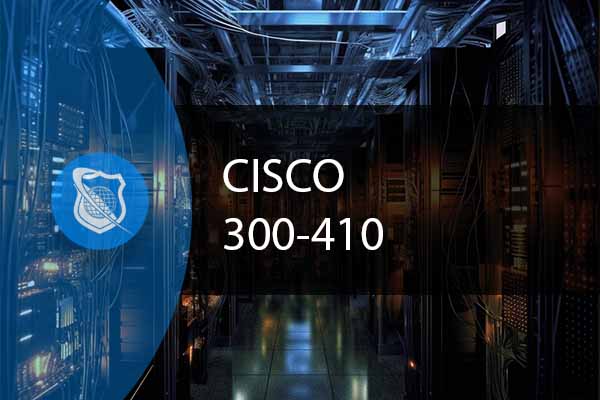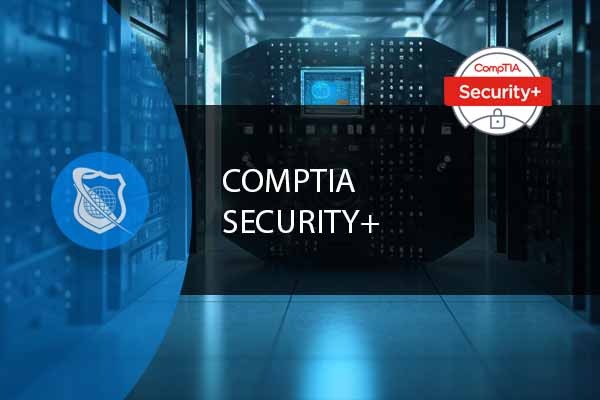The 300-410 Cisco ENARSI exam is a crucial step for those aspiring to earn the CCNP Enterprise certification. This certification is designed to validate your skills and knowledge in advanced routing and services, making it an essential milestone for network professionals looking to advance their careers. In this blog post, we’ll provide an overview of the ENARSI exam, its makeup, and share some common questions that may appear on the test.
Propel Your Cisco Networking Skills forward
Become a pro in advanced routing and services with our Cisco 300-410 ENARSI course. Enroll now and get certified!
Understanding the 300-410 ENARSI Exam
The Cisco ENARSI (Implementing Cisco Enterprise Advanced Routing and Services) exam is one of the core exams for the CCNP Enterprise certification. It assesses your ability to implement and troubleshoot advanced routing technologies and services. Here’s what you need to know about the exam makeup:
Exam Code: 300-410 ENARSI
Exam Duration: 90 minutes
Exam Format: The exam consists of multiple-choice questions (MCQs), multiple-choice single answer (MCSA) questions, and multiple-choice multiple answer (MCMA) questions.
Passing Score: Cisco does not disclose the passing score, but it typically ranges between 825 and 850 out of 1000.
Exam Topics: The ENARSI exam covers a range of topics, including:
- Layer 3 Technologies: This section focuses on OSPF, EIGRP, and BGP routing protocols. Expect questions on route redistribution, route selection, and troubleshooting.
- VPN Technologies: You’ll be tested on various VPN technologies, such as GRE, IPsec, DMVPN, and MPLS.
- Infrastructure Security and Services: Questions in this section may cover security features like ACLs, prefix lists, and control-plane policing, as well as services like DHCP, NAT, and HSRP.
- Infrastructure Services: This section explores technologies like Syslog, SNMP, and NetFlow for network monitoring and management.
- Network Assurance: Expect questions related to device monitoring, network telemetry, and troubleshooting methodologies.
Common Questions on the ENARSI Exam
While Cisco keeps the specific exam questions confidential, you can prepare effectively by studying the key topics. Here are some example questions and answers related to the 300-410 ENARSI exam:
Layer 3 Technologies Example Q&A’s
Let’s delve deeper into the Layer 3 Technologies topic for the Cisco ENARSI (300-410) exam and provide four potential questions with detailed answers:
1. OSPF Troubleshooting:
Question 1: You are tasked with troubleshooting an OSPF network where two routers in the same area are failing to establish an adjacency. What could be the potential reasons for this issue, and how would you troubleshoot it?
Answer 1: There could be several reasons for OSPF adjacency failures between routers in the same area:
- Misconfigured OSPF Parameters: Verify that the routers have the same OSPF area ID, authentication settings (if used), and subnet masks on their interfaces.
- Network Type Mismatch: Ensure that the OSPF network type (e.g., broadcast, point-to-point, etc.) is consistent on both interfaces.
- Hello and Dead Intervals: Check if the OSPF hello and dead intervals match on both routers’ interfaces.
- Interface State: Confirm that the physical and data link layer on the connecting interfaces are operational.
- Firewall or ACLs: Ensure that there are no access control lists (ACLs) or firewalls blocking OSPF packets between the routers.
To troubleshoot, you can use commands like show ip ospf interface, show ip ospf neighbor, and debug ip ospf adj to gather information about the OSPF process and identify the root cause of the adjacency failure.
Question 2: What OSPF LSA type is responsible for advertising AS-external routes, and how does it contribute to OSPF routing tables?
Answer 2: OSPF uses Type 5 LSAs (Link-State Advertisements) to advertise AS-external routes, which are routes learned from external routing domains or autonomous systems. These LSAs are generated by an Autonomous System Border Router (ASBR) and are flooded throughout the OSPF domain.
When Type 5 LSAs are received by OSPF routers, they are used to populate the OSPF routing table. OSPF routers use the Type 5 LSA information, including the external route’s metric and next-hop information, to determine the best path to reach external destinations. This enables OSPF routers to incorporate external routes into their routing decisions.
2. EIGRP Configuration:
Question 1: Configure EIGRP on two routers in different Autonomous Systems (AS) and explain the necessary steps to ensure they form neighbor adjacencies.
Answer 1: To configure EIGRP on two routers in different ASs and ensure they form neighbor adjacencies, follow these steps:
- Enable EIGRP: Enter global configuration mode and use the
router eigrp [AS number]command to enable EIGRP and specify the AS number on both routers. - Define Networks: Use the
network [network address] [wildcard mask]command under the EIGRP process to specify the networks to be advertised by EIGRP. - Authentication (Optional): If authentication is required, configure it using the
authenticationcommands, such asauthentication modeandauthentication key-chain. - Adjust Metric (Optional): You can modify EIGRP metric parameters using the
metric weightscommand to influence route selection. - Verify Adjacency: Use the
show ip eigrp neighborscommand to verify that EIGRP neighbors have formed an adjacency. Ensure that the routers’ interfaces are in the same subnet and their autonomous system numbers match. - Troubleshoot (if needed): If the adjacency does not form, use EIGRP-specific troubleshooting commands like
show ip eigrp interfacesanddebug eigrp packetsto identify and resolve issues.
Question 2: How does EIGRP handle route summarization, and what are the benefits of summarizing routes?
Answer 2: EIGRP supports route summarization by using the summary-address command under the EIGRP process configuration. When summarization is configured, EIGRP advertises a summarized route rather than individual subnets within that summary range.
Benefits of route summarization in EIGRP include:
- Reduced Routing Table Size: Summarization reduces the number of entries in the EIGRP routing table, conserving memory and CPU resources on routers.
- Improved Convergence: Summarized routes can help EIGRP converge faster in case of topology changes, as there are fewer routes to update.
- Reduced Bandwidth Usage: By advertising fewer routes, summarization decreases the amount of EIGRP routing updates sent over the network.
- Simplified Routing Management: Summarization simplifies routing management, especially in large networks, by reducing the number of routing table entries to maintain.
Question 3: Explain the concept of EIGRP Composite Metric and the factors it considers when calculating the metric.
Answer 3: EIGRP uses a Composite Metric to calculate the best path to reach a destination network. The EIGRP Composite Metric comprises several factors, including:
- Bandwidth: The minimum bandwidth of the slowest link in the path to the destination.
- Delay: The cumulative delay of all links in the path.
- Reliability: A measure of link reliability, with higher values indicating more reliable links.
- Load: A measure of link utilization, with lower values indicating less congested links.
- MTU (Maximum Transmission Unit): The MTU of the path to the destination.
The default formula for calculating the EIGRP Composite Metric is quite complex, but it can be customized using the metric weights command. By adjusting these weights, network administrators can influence the EIGRP metric calculation to suit specific network requirements.
Question 4: How does EIGRP support unequal-cost load balancing, and what are its benefits?
Answer 4: EIGRP supports unequal-cost load balancing, which allows routers to distribute traffic across multiple paths with different metric values. Benefits of unequal-cost load balancing include:
- Optimal Use of Resources: It maximizes the utilization of available network paths, leading to efficient network resource utilization.
- Redundancy: In case of a link failure, traffic can still be routed through the alternate path, improving network redundancy.
- Load Distribution: Unequal-cost load balancing distributes traffic based on the capacity and performance of network links, which can lead to better load distribution and reduced congestion.
To configure unequal-cost load balancing in EIGRP, use the maximum-paths command under the EIGRP process configuration, specifying the number of paths to use for load balancing.
Question 5: Explain the concept of EIGRP Stub Routing and its significance in network design.
Answer 5: EIGRP Stub Routing is a feature in EIGRP that can be configured on routers within a network to reduce the amount of routing information they receive from their EIGRP neighbors. This is particularly useful in large networks or branch offices where you want to minimize the routing table size and reduce the processing overhead on routers.
Significance of EIGRP Stub Routing:
- Routing Table Optimization: By configuring a router as a stub router, it will not receive detailed route information from upstream routers. Instead, it will only receive summary routes, default routes, and connected routes. This helps optimize the routing table and reduce memory usage on the stub router.
- Security: Stub routing enhances security by preventing unauthorized routers from injecting routes into the EIGRP domain. Stub routers only accept routes from trusted sources, typically the upstream routers.
- Reduced Query Load: In case of a network failure, routers configured as stubs will not send EIGRP queries to their upstream neighbors, further reducing network traffic and potential issues related to route queries.
- Simplified Configuration: Stub routing simplifies EIGRP configuration by allowing you to configure routers at the network edge without worrying about complex route propagation.
To configure a router as a stub router in EIGRP, you can use the eigrp stub command under the EIGRP process configuration.
2.VPN Technologies Example Q&A’s
here are five potential exam questions and answers related to VPN Technologies for the Cisco ENARSI (300-410) exam:
1. Question: Explain the key differences between GRE and IPsec VPNs. When would you choose one over the other in a network design?
Answer:
- GRE (Generic Routing Encapsulation): GRE is a protocol used for creating point-to-point or multipoint connections between remote sites. It primarily provides encapsulation and doesn’t offer inherent encryption or authentication.
- IPsec (Internet Protocol Security): IPsec is a suite of protocols used for secure communication over IP networks. It provides encryption, authentication, and data integrity.
You would choose GRE when you need to create a simple, transparent, and lightweight tunnel between remote sites. IPsec is preferable when security and data confidentiality are paramount, as it encrypts traffic between endpoints.
2. Question: Describe the purpose of Dynamic Multipoint Virtual Private Network (DMVPN) and provide an example scenario where it is beneficial.
Answer: DMVPN is a VPN technology that simplifies the establishment of secure connections between remote sites. It creates a hub-and-spoke topology where remote sites can communicate directly with each other, even if they don’t have direct connectivity. An example scenario where DMVPN is beneficial is in a retail business with numerous branch locations. Each branch connects to a central hub (data center) using DMVPN, allowing branches to communicate efficiently without requiring individual point-to-point connections.
3. Question: What are the primary components of an IPsec VPN, and how do they work together to ensure secure communication?
Answer: The primary components of an IPsec VPN are as follows:
- Security Associations (SA): SAs define the security parameters for communication between peers, including encryption and authentication methods.
- Internet Key Exchange (IKE): IKE is used to establish and manage SAs between peers, negotiating encryption and authentication settings.
- IPsec Protocols (AH and ESP): Authentication Header (AH) and Encapsulating Security Payload (ESP) are IPsec protocols that provide authentication, integrity, and encryption for data packets.
Together, these components ensure secure communication by establishing SAs, negotiating security settings, and encrypting and authenticating data packets between VPN peers.
4. Question: Compare and contrast the transport mode and tunnel mode in IPsec. When would you use one mode over the other?
Answer:
- Transport Mode: In transport mode, only the payload (data) of the IP packet is encrypted and authenticated. The original IP header remains intact. Transport mode is typically used for end-to-end communication between hosts or devices within a network.
- Tunnel Mode: In tunnel mode, the entire IP packet (including the original IP header) is encapsulated within a new IP packet. This mode is used when you want to create a secure connection between networks or when passing traffic through a VPN gateway.
You would use transport mode for host-to-host or device-to-device communication within a network. Tunnel mode is chosen when you need to create a secure connection between networks or protect traffic passing through a VPN gateway.
5. Question: What is the purpose of split tunneling in VPN configurations, and what are the potential security implications?
Answer:
- Purpose of Split Tunneling: Split tunneling is a VPN configuration option that allows some network traffic to be sent through the VPN tunnel while other traffic is routed directly to the internet or a local network. It’s primarily used to optimize network performance by reducing the load on the VPN tunnel and conserving bandwidth.
However, it can have security implications because traffic not sent through the VPN tunnel is exposed to potential risks, such as eavesdropping or interception, as it traverses the unsecured portion of the network. Network administrators must carefully consider the security requirements when implementing split tunneling and implement appropriate security policies to mitigate potential risks.
Secure Your Networks and Prevent Password Breaches
Our robust CompTIA Sec+ course is the perfect resouce to ensure your company’s most valuable assets are safe. Up your security skills with this comprehensive course at an exceptional price.
3. Infrastructure Security and Services Example Q&A’s
here are five potential exam questions and answers related to Infrastructure Security and Services for the Cisco ENARSI (300-410) exam:
1. Question: Explain the purpose of Access Control Lists (ACLs) in network security. Provide an example scenario where ACLs can be used effectively.
Answer:
- Purpose of ACLs: Access Control Lists (ACLs) are used to control and filter traffic entering or exiting a network device, such as a router or firewall. They can permit or deny traffic based on various criteria, such as source/destination IP addresses, ports, and protocols.
- Example Scenario: In an enterprise network, ACLs can be used to restrict access to sensitive resources. For instance, you can create ACLs to allow only specific IP ranges to access a server hosting critical data while denying access to all other IP addresses.
2. Question: Describe the concept of Network Address Translation (NAT) and its role in network security.
Answer:
- NAT Concept: Network Address Translation (NAT) is a technique used to modify network address information in packet headers while in transit. It allows multiple devices within a private network to share a single public IP address. NAT can be used to map private IP addresses to a single public IP address or to a pool of public IP addresses.
- Role in Network Security: NAT enhances network security by hiding the internal IP addresses of devices within a private network. This obscures the internal network topology, making it more challenging for external attackers to identify and target specific devices.
3. Question: Explain the purpose of Control-Plane Policing (CoPP) in network security and provide an example of its application.
Answer:
- Purpose of CoPP: Control-Plane Policing (CoPP) is a security feature used to protect a network device’s control plane from excessive traffic or malicious attacks. The control plane includes critical processes like routing, management, and protocol handling.
- Example Application: CoPP can be applied to limit the rate of incoming ICMP (Internet Control Message Protocol) traffic directed at the router. This helps prevent Distributed Denial of Service (DDoS) attacks that target the control plane by overwhelming it with ICMP requests.
4. Question: Differentiate between Standard ACLs and Extended ACLs in terms of their functionality and use cases.
Answer:
- Standard ACLs: Standard Access Control Lists (ACLs) filter traffic based solely on source IP addresses. They are used for simple access control decisions and are typically applied closer to the destination.
- Extended ACLs: Extended Access Control Lists (ACLs) provide more granular control by filtering traffic based on source and destination IP addresses, port numbers, and protocols. They are versatile and can be used for complex access control decisions, often applied closer to the source.
When deciding between standard and extended ACLs, consider the level of granularity required for your access control rules. Standard ACLs are suitable for basic filtering, while extended ACLs offer finer control over traffic.
5. Question: What is the purpose of a Stateful Firewall, and how does it differ from a Stateful Inspection Firewall?
Answer:
- Purpose of Stateful Firewall: A Stateful Firewall is designed to monitor and track the state of active connections, allowing it to make intelligent decisions about allowing or denying traffic based on the context of the connection. It keeps track of the state of each connection and allows return traffic associated with established connections.
- Difference from Stateful Inspection Firewall: A Stateful Inspection Firewall is a specific type of Stateful Firewall that not only tracks connection state but also inspects packet content and enforces more advanced security policies. It examines the application-layer payload and can make decisions based on application-specific rules.
The key difference is that while both track connection state, Stateful Inspection Firewalls provide deeper inspection and context-aware filtering, making them more effective in identifying and blocking advanced threats.
Propel Your Cisco Networking Skills forward
Become a pro in advanced routing and services with our Cisco 300-410 ENARSI course. Enroll now and get certified!
4. Infrastructure Services Example Q&A’s
Here are five potential exam questions and answers related to Infrastructure Services for the Cisco ENARSI (300-410) exam:
1. Question: What is the role of SNMP (Simple Network Management Protocol) in network management, and how does it work?
Answer:
- Role of SNMP: SNMP is a protocol used for the management and monitoring of network devices, such as routers, switches, and servers. It enables administrators to retrieve information from these devices and configure them remotely.
- How it Works: SNMP operates on a client-server model. SNMP managers (clients) request information from SNMP agents (servers) using SNMP GET and SET operations. Agents store data in Management Information Bases (MIBs) and respond to queries from managers. SNMP is extensible and supports different versions, with SNMPv3 being the most secure, as it provides authentication and encryption.
2. Question: Describe the purpose of Syslog in network monitoring and troubleshooting. Provide an example of how it is used.
Answer:
- Purpose of Syslog: Syslog is a standardized protocol used for sending and receiving log messages and event notifications from network devices. It plays a critical role in network monitoring, troubleshooting, and security analysis.
- Example Usage: Suppose a network administrator wants to monitor the performance and error messages from multiple routers and switches in a network. Syslog can be configured on these devices to send log messages to a central syslog server. The administrator can then analyze these logs for anomalies, errors, or performance issues, aiding in proactive troubleshooting and network management.
3. Question: Explain the purpose of NetFlow in network traffic analysis and its benefits.
Answer:
- Purpose of NetFlow: NetFlow is a network protocol used for collecting and analyzing traffic data from routers, switches, and other network devices. It provides detailed information about network traffic patterns, allowing for in-depth analysis.
- Benefits:
- Traffic Visibility: NetFlow provides visibility into which devices are communicating, the volume of traffic, and the types of applications or protocols in use.
- Bandwidth Monitoring: It helps monitor and manage bandwidth utilization, identifying areas of congestion or network abuse.
- Security Analysis: NetFlow data can be used for security analysis, including the detection of abnormal traffic patterns and potential security breaches.
- Capacity Planning: It aids in capacity planning by providing historical data on network usage, helping organizations scale their infrastructure to meet future demands.
4. Question: How does SNMP polling differ from SNMP trapping in network management, and when would you use each method?
Answer:
- SNMP Polling: SNMP polling is a proactive method where the SNMP manager periodically queries SNMP agents for information. The manager sends GET requests to retrieve specific data from agents. SNMP polling is suitable for regular monitoring and data collection tasks.
- SNMP Trapping: SNMP trapping is reactive, where SNMP agents send unsolicited SNMP trap messages to the SNMP manager when specific events or conditions occur. Traps are used for real-time event notification and alerting.
You would use SNMP polling for regular monitoring and data collection, such as tracking interface bandwidth usage. SNMP trapping is used for immediate notification of critical events, such as a device going down or a security breach, where timely response is crucial.
5. Question: What is the role of DHCP (Dynamic Host Configuration Protocol) in network services, and how does it work?
Answer:
- Role of DHCP: DHCP is a network protocol that automates the assignment of IP addresses and other network configuration parameters to devices in a network. It simplifies IP address management and ensures that devices can connect to the network without manual configuration.
- How it Works: When a device (DHCP client) joins a network, it sends a DHCP request. A DHCP server receives this request, selects an available IP address from its pool, and assigns it to the client, along with other network configuration parameters like subnet mask, gateway, and DNS servers. DHCP helps prevent IP address conflicts and streamlines the process of connecting devices to a network.
5. Network Assurance Example Q&A’s
here are five potential exam questions and answers related to Network Assurance for the Cisco ENARSI (300-410) exam:
1. Question: Describe the key steps involved in the OSI model-based troubleshooting methodology.
Answer: The OSI model-based troubleshooting methodology consists of several steps:
- Define the Problem: Clearly define the issue or problem you are trying to address, such as network connectivity loss or slow performance.
- Gather Information: Collect relevant data and information about the problem, including logs, error messages, and configuration details.
- Analyze Information: Examine the gathered information to identify potential causes or areas where the problem might exist.
- Identify Potential Causes: Based on the analysis, create a list of possible causes for the issue. Narrow down the list to the most likely culprits.
- Test Solutions: Implement and test potential solutions or workarounds for the problem. Monitor the impact of changes on the network.
- Implement the Solution: Once a valid solution is identified, implement it across the affected network devices.
- Document the Solution: Document the entire troubleshooting process, including the problem description, analysis, solutions tested, and the final resolution. This documentation is valuable for future reference and knowledge sharing.
2. Question: Explain the concept of Network Telemetry and its importance in network assurance.
Answer:
- Network Telemetry: Network telemetry refers to the collection of real-time data and statistics from network devices and infrastructure components. This data includes information about network performance, traffic patterns, errors, and anomalies.
- Importance in Network Assurance: Network telemetry is essential for network assurance because it provides visibility into the network’s current state. It allows network administrators to monitor network health, detect issues in real time, and make informed decisions about network optimization, security, and troubleshooting.
3. Question: What is the purpose of a Routing Protocol Monitoring tool, and how does it contribute to network assurance?
Answer:
- Purpose of Routing Protocol Monitoring: A Routing Protocol Monitoring tool is used to continuously monitor the status and performance of routing protocols such as OSPF, EIGRP, and BGP in a network.
- Contribution to Network Assurance: This tool ensures that routing protocols are functioning correctly and that routing tables are consistent. It detects anomalies, route flaps, and convergence issues, allowing administrators to address problems promptly and maintain network stability and reliability.
4. Question: Describe the key components of Network Device Monitoring and how they contribute to network assurance.
Answer:
- Key Components of Network Device Monitoring:
- SNMP (Simple Network Management Protocol): SNMP allows network devices to be queried for information about their status and performance. It provides data on CPU utilization, memory usage, interface statistics, and more.
- Syslog: Syslog provides event logging and monitoring, helping administrators track device events, errors, and warnings.
- Network Management Software: Network management software collects and analyzes data from SNMP and Syslog, providing a centralized view of the network’s health. It often includes alerting and reporting features.
- Contribution to Network Assurance: These components together provide real-time visibility into the operational status of network devices. Monitoring helps detect issues early, facilitates proactive maintenance, and supports quick response to network problems, ensuring network assurance.
5. Question: Explain the concept of Network Device Configuration Management and its role in network assurance.
Answer:
- Network Device Configuration Management: This practice involves documenting, tracking, and managing the configurations of network devices such as routers, switches, and firewalls. It includes version control, change management, and backup of device configurations.
- Role in Network Assurance: Network Device Configuration Management is crucial for network assurance because it ensures that device configurations are consistent, secure, and well-documented. It enables quick recovery in case of configuration errors or device failures, enhances security by monitoring for unauthorized changes, and supports compliance with network policies and standards.
Cisco 300-410 ENARSI Exam FAQ: Mastering the Path to CCNP Enterprise Success
What prerequisites are needed before taking the Cisco 300-410 ENARSI exam?
To sit for the Cisco 300-410 ENARSI exam, candidates should have a good understanding of networking basics and preferably hold the CCNA certification or have equivalent knowledge. Additionally, it’s recommended to have hands-on experience with Cisco enterprise networking solutions. This exam is a part of the CCNP Enterprise certification, so preparing thoroughly is crucial for success.
What topics are covered in the Cisco 300-410 ENARSI exam?
The Cisco 300-410 ENARSI exam covers a range of topics crucial for advanced routing and services within enterprise networks. Key areas include the implementation of EIGRP, OSPF, and BGP, as well as VPN services, infrastructure security, and services. Understanding these areas is essential for passing the exam and succeeding in the CCNP Enterprise pathway.
How long should I prepare for the Cisco 300-410 ENARSI exam to achieve CCNP Enterprise certification?
Preparation time can vary based on your background and familiarity with the exam topics. Generally, candidates spend 3 to 6 months studying for the Cisco 300-410 ENARSI exam. This includes practical experience, studying official Cisco materials, and possibly attending training courses. Tailoring your preparation to cover all exam topics thoroughly will enhance your chances of achieving CCNP Enterprise certification success.
Are there official training courses available for the Cisco 300-410 ENARSI exam?
Yes, Cisco offers official training courses for the Cisco 300-410 ENARSI exam. These courses are designed to provide in-depth knowledge of the exam topics, including both theoretical concepts and practical skills. Candidates can choose from self-paced online courses, instructor-led classes, and hands-on lab sessions to best suit their learning style and prepare effectively for their CCNP Enterprise certification journey.
What strategies can help me succeed in the Cisco 300-410 ENARSI exam?
Successful strategies for the Cisco 300-410 ENARSI exam include a mix of theoretical study and practical experience. Utilize official Cisco learning materials, engage with online forums and study groups, and practice with real or simulated Cisco equipment to gain hands-on experience. Time management during the exam is also crucial, so practice with mock exams to become familiar with the format and pacing. Focusing on these strategies will aid in mastering the content needed for CCNP Enterprise certification success.

Lock In Our Lowest Price Ever For Only $14.99 Monthly Access
Your career in information technology last for years. Technology changes rapidly. An ITU Online IT Training subscription offers you flexible and affordable IT training. With our IT training at your fingertips, your career opportunities are never ending as you grow your skills.
Plus, start today and get 10 free days with no obligation.
Conclusion:
The Cisco ENARSI (300-410) exam is a challenging yet essential step toward earning your CCNP Enterprise certification. By understanding the exam makeup and focusing on the key topics, you can prepare effectively and increase your chances of success. Remember, while the specific questions are not disclosed, a solid grasp of the exam objectives will help you excel on exam day. Good luck on your journey to becoming a CCNP Enterprise professional!

























